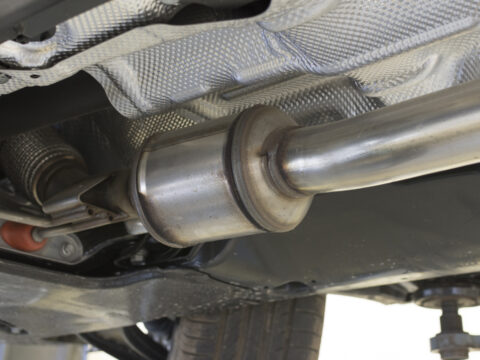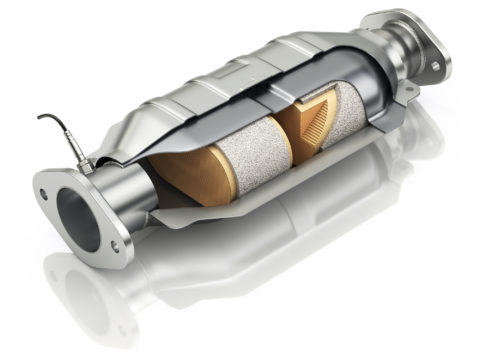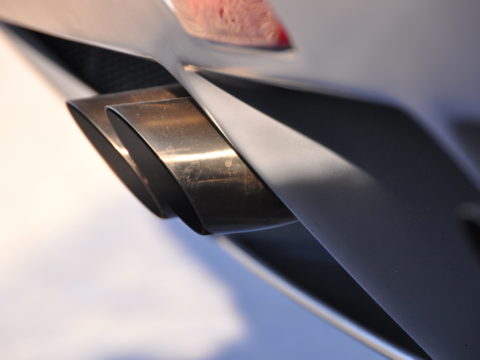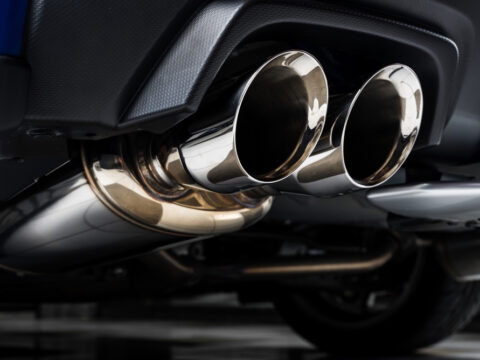Catalytic converters are an intricate part of regular and safe vehicle function. Not only do they help reduce harmful emissions, but they also play a critical role in the overall exhaust system.
In order to maintain your catalytic converter and keep it functioning optimally, it’s essential to install a catalytic converter shield.
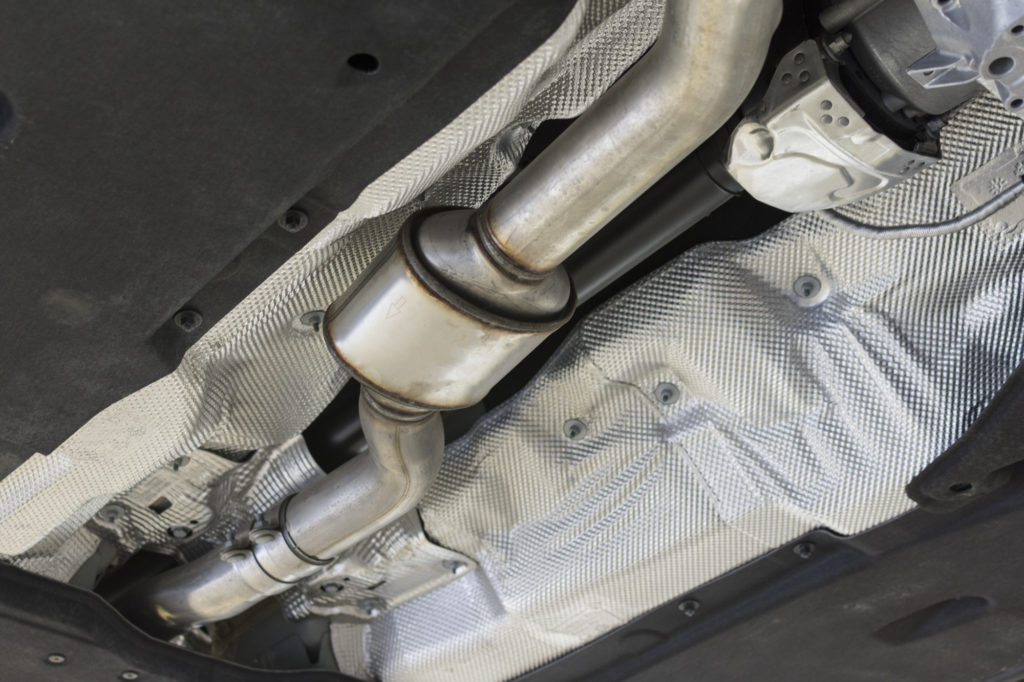
This guide will provide you with the information you need to know about catalytic converter shields and choosing the right cover for your vehicle.
Contents
What Is a Catalytic Converter Shield/Cover?
A catalytic converter shield is a device that is placed over a catalytic converter that works as a barrier to protect other components from the heat that emits from it.
A cover is a piece of material placed over an object to protect it from the environment or keep it from being seen. In this case, the catalytic converter shield/cover protects the catalytic converter from environmental elements, debris, overheating, and theft.
What Is a Catalytic Converter Heat Shield Made Of?
A catalytic converter heat shield can be made of various materials, but the most common material used is stainless steel. Others are made of woven glass with a flexible aluminized polyester film finish. Some are made of woven silica with a flexible mylar finish.
What Does a Catalytic Converter Heat Shield Do?
Here are the primary functions of a catalytic converter shield.
Reduces Interior Temperatures
This lowers wear and tear on the converter and related components and protects transmissions from excessive heat. It also prevents radiant heat from the converter from melting nearby plastic or rubber components on the vehicle.
If the converter gets too hot, it can potentially damage other components on the car or, worse, catch fire.
Prevents Clogs in the Converter
It can prevent foreign objects from entering the converter and damaging the catalyst. This is important because if a foreign object enters the converter, it can cause the catalyst to become clogged, which will reduce its efficiency.
Keeps the Converter Clean and Reduces Emissions
The cover reduces emissions by trapping pollutants before they have a chance to enter the converter. It also keeps the converter clean by preventing debris from entering it.
It also keeps exterior contaminants and moisture from entering the converter. If moisture or any other pollutants were to get inside the converter, it could cause damage and reduce its efficiency.
Deters Theft
If a thief sees that the converter is shielded or covered, they may be less likely to try and steal it because it will take them longer, cause them to make more noise, and possibly get them caught in the act of stealing the converter.
How Does a Catalytic Converter Shield Work?
A catalytic converter shield works by deflecting or shielding the catalytic converter from environmental elements and debris. It also helps to keep the catalytic converter cooler by protecting it from excessive heat.
It essentially creates a barrier between the converter and the environment, which helps to keep it clean and functioning properly.
It works by keeping the converter cooler, which prevents it from becoming damaged or clogged.
When it comes down to deterring thieves, it works by limiting their access to the converter. Thieves typically slide under the car and saw off the converter with a handheld saw. The process only takes about a few minutes.
Newer cars are usually the likely targets because they have more expensive catalytic converters. The value of the part depreciates with time.
The goal of a thief is to get the part as quickly as possible. While having a shield may not prevent the theft, it will lower the chances of it happening.
How Important Is a Catalytic Converter Heat Shield?
A catalytic converter heat shield is essential because it helps to protect the catalytic converter from environmental elements and debris. It also helps to keep the catalytic converter cooler by protecting it from excessive heat.
To better understand this, let’s look at what the catalytic converter does for a car. A catalytic converter helps to reduce emissions from a vehicle. It does this by converting harmful pollutants into less harmful ones.
If the converter becomes too hot, it can potentially damage other components on the vehicle and not work as well as it should. This is why it’s essential to have a shield that helps to keep it cool.
Without a shield, the converter would be more susceptible to damage and would likely not function well over time.
Do You Need a Catalytic Converter Heat Shield?
A catalytic converter heat shield is not necessary for all vehicles, but it is highly recommended. If your car does not have a catalytic converter heat shield, it is crucial to regularly inspect the converter to ensure that it is not damaged.
The heat shield does a great job at preventing the converter from becoming too hot, and it is a reasonably inexpensive part to install. It is a good idea to have one installed on your vehicle. One can find a catalytic converter shield at some auto parts stores or online.
Do Catalytic Converter Shields Work?
Catalytic converter shields work by drawing deflecting heat and debris away from the converter. They especially work at deterring thieves. In many cases, the shield has tamper-proof bolts that make it near impossible for thieves to remove it.
Then there is the probability of the converter getting so hot that it catches fire because it was not shielded from the heat.
A catalytic converter shield lowers the chances of this happening immensely.
How Do You Make a Catalytic Converter Shield?
Making your own catalytic converter shield is easier than you can imagine. It is an excellent alternative to purchasing one online, especially when you likely have most of the supplies in your garage.
Tools and Equipment Needed
- A heat-resistant material (stainless steel, woven glass, etc.)
- Scissors
- Plasma cutter
- Security sheet metal screws
- Gorilla tape
- Magic marker
- Tape measure
- Cardboard
Step 1: Make a Template
Use the cardboard and tape measure to create a template for the actual shield.
This is done by placing the cardboard against the catalytic converter and drawing around it. You want to get a perfect fit the first time without having to make any adjustments.
Step 2: Draw an Outline
Use the magic marker to draw around the edges where you feel the best fit would be.
You want to make sure that the shield covers the body of the catalytic converter and even a few inches of the pipe that comes out of each end. The bigger you make the guard, the more you lower the chances of it being stolen.
Step 3: Cut Out Your Template
Cut out the template and use it as a guide to cut the heat-resistant material with the plasma cutter.
You will only need one template, even though you will be making two sides for the shield. One side of the shield will go between the bottom of the car and the catalytic converter. The other side will go between the catalytic converter and the ground.
Make sure that the shield is big enough to cover the catalytic converter completely. If it is not, you can cut it down to size.
Step 4: Attach It to Your Car
Use security sheet metal screws to attach the shield to the vehicle. Make sure that the screws are not too long, or they will puncture the shield. Tape the seams of the shield to prevent moisture and debris from entering.
That’s it! You’ve now made your own catalytic converter shield!
How Much Is a Catalytic Converter Shield?
A catalytic converter shield can cost anywhere from $10 to $600, depending on the make and model of the vehicle. It is essential to choose the best shield for your vehicle model to ensure effectiveness.
How Much Does It Cost to Install a Catalytic Converter Heat Shield?
It typically costs between $50 and $100 to install a catalytic converter heat shield. However, the cost will vary depending on the make and model of the vehicle and the price your mechanic charges.
How Much Does It Cost to Replace a Catalytic Converter Heat Shield?
The cost to replace a catalytic converter heat shield can vary depending on the make and model of the vehicle. However, it typically costs between $100 and $600. The price depends on the brand you purchase and the mechanic you choose to perform the job.
Who Installs Catalytic Converter Shields?
A mechanic or an auto shop typically installs catalytic converter shields. It is essential to choose a reputable and qualified shop to install your shield to ensure it is done properly.
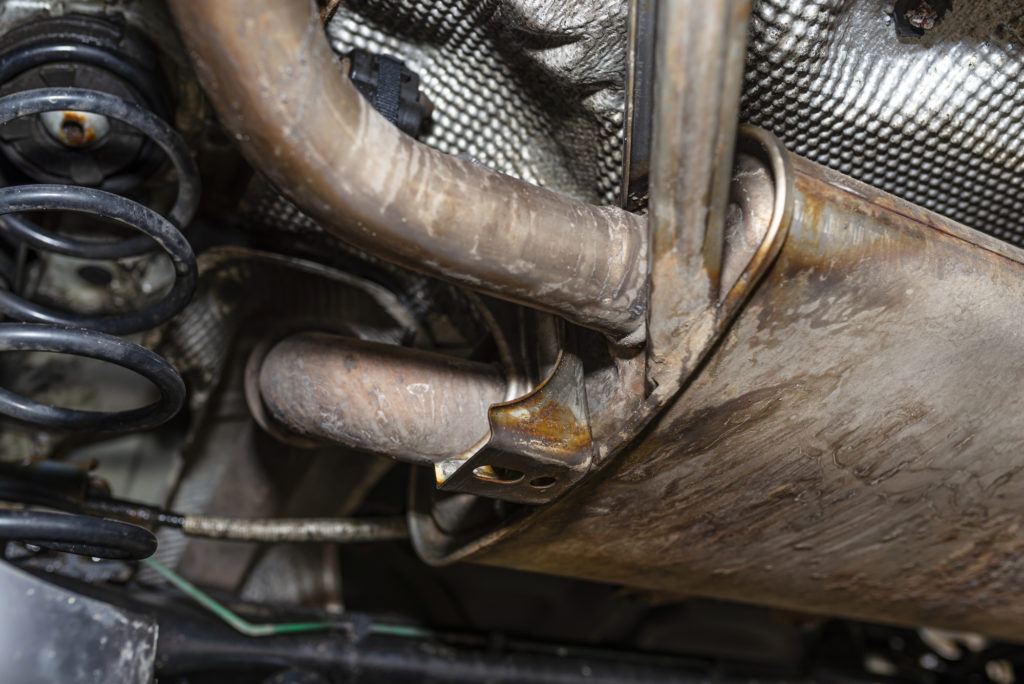
Where to Get a Catalytic Converter Shield?
You have options on where to purchase your catalytic converter shield. You can buy them online, at an auto shop, or from a known vendor.
Many excellent brands make catalytic converter shields. However, some of the best brands include LOSTAR, Cat Security, Heatshield Products, and MillerCat.
If you are unsure which one to purchase, contact the vendor who can help you make an informed decision on which one is best for your car.
LOSTAR
LOSTAR has an excellent catalytic converter protection shield made of stainless steel. It’s set up so that the converter cannot be accessed unless the cover is removed. It comes with a one-year limited warranty and is easy to install.
Cat Security
Cat Security has a great catalytic converter shield made of heat-resistant material. It fits most converters and is easy to install. It comes with a one-year limited warranty.
They partner with Toyota to educate communities on the need for catalytic converter shields and theft. Older Toyota Prius models are the number one target for catalytic converter theft.
MillerCat
MillerCat has a great catalytic converter shield that is made of stainless steel. The guard is available for all Toyota, Lexus, and Honda models. If you prefer their shield over the others, you can contact them to see if they make a shield for your make and model of the vehicle.
Heatshield Products
The Heatshield catalytic converter shield is a little different from the others. It is a wrap that covers the round part of the converter. If theft is not a concern, this option works just as fine.
It blocks up to 70 percent of the heat and works on OEM and aftermarket converters. The material is made from their BioCool thermal insulated material that can withstand up to 1800 degrees of heat.
It comes with thermal ties to lock it in place. The extraordinary thing about this option is that you don’t have to worry about size and fitting since it simply wraps around the converter.
FAQs
A catalytic converter heat shield is an essential component of your vehicle that helps to protect the catalytic converter from environmental elements and debris. It also helps keep the converter cooler by deflecting or shielding it from excessive heat. If you still have questions on the topic, check out the quick answers below.
Can you drive without a catalytic converter shield?
You can drive without a catalytic converter shield, but it is not recommended. If your vehicle does not have a heat shield, it is essential to have your mechanic pay attention to it during your inspection to ensure that it is not damaged.
Does a cat shield prevent catalytic converter theft?
There is no evidence that a catalytic converter shield prevents catalytic converter theft. Even though it may not prevent robbery, it can work as a deterrent. If you purchase a shield with tamper-proof bolts, they won’t remove it without cutting it off.
Do I need to replace the heat shield on my catalytic converter?
You may need to replace the heat shield on your catalytic converter if it is damaged or if it is not effective at deflecting or shielding the converter from environmental elements and debris.
Can I install a catalytic converter myself?
Yes, you can install a catalytic converter yourself. However, it is essential to choose the right shield for your vehicle to ensure effectiveness. You can also look at step-by-step DIY guides and suitable YouTube tutorial videos online.

